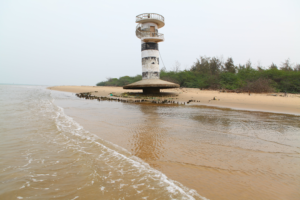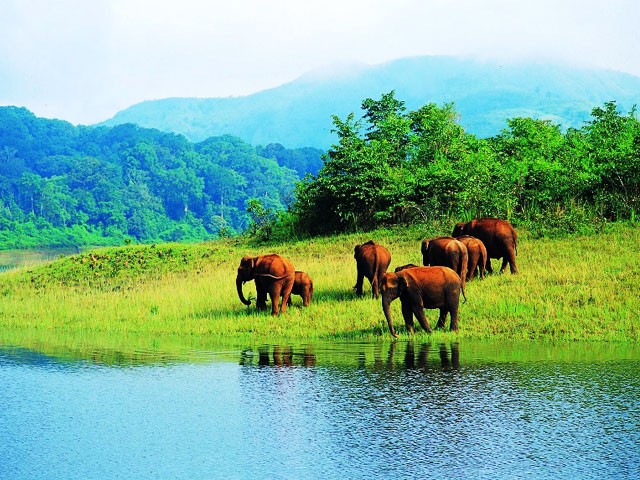Introduction:
Kerala, known for its lush landscapes and serene backwaters, is also a haven for wildlife enthusiasts. The state’s diverse ecosystems, ranging from tropical forests to grasslands and wetlands, harbor a rich variety of flora and fauna. In this comprehensive guide, we’ll take you on a virtual tour of Kerala’s best national parks and wildlife sanctuaries, offering insights into the unique experiences each destination provides. Whether you’re an avid birder, a wildlife photographer, or simply a nature lover, Kerala’s wildlife sanctuaries promise unforgettable encounters with some of India’s most fascinating creatures.
- Periyar National Park and Tiger Reserve
Location: Thekkady, Idukki District
Area: 925 sq km
Key Features:
- One of India’s most popular tiger reserves
- Centered around the artificial Periyar Lake
- Home to elephants, tigers, leopards, and numerous bird species
Activities:
- Boat safaris on Periyar Lake
- Guided nature walks and bamboo rafting
- Night patrols with forest guards (special program)
Best Time to Visit: October to May
- Silent Valley National Park
Location: Palakkad District
Area: 237.52 sq km
Key Features:
- Part of the Nilgiri Biosphere Reserve
- One of the last undisturbed tracts of South Western Ghats mountain rain forests
- Rich in endemic species
Highlights:
- Home to lion-tailed macaques, Nilgiri langurs, and Malabar giant squirrels
- Over 200 species of birds
- Unique silent environment due to lack of cicadas
Best Time to Visit: December to April
- Eravikulam National Park
Location: Idukki District
Area: 97 sq km
Key Features:
- Home to the largest population of Nilgiri Tahr (endangered mountain goat)
- Rolling grasslands and shola forests
- Location of Anamudi, the highest peak in South India
Activities:
- Trekking and wildlife viewing
- Visit during the Neelakurinji bloom (once every 12 years)
Best Time to Visit: September to November and January to March
- Wayanad Wildlife Sanctuary
Location: Wayanad District
Area: 344.44 sq km
Key Features:
- Part of the Nilgiri Biosphere Reserve
- Diverse fauna including elephants, tigers, and panthers
- Rich bird life with over 200 species
Activities:
- Jeep safaris and guided trekking
- Visit to Muthanga and Tholpetty eco-tourism zones
Best Time to Visit: October to May
- Parambikulam Tiger Reserve
Location: Palakkad District
Area: 643.66 sq km
Key Features:
- High density of tigers
- Home to endemic species like Nilgiri langur and lion-tailed macaque
- Famous for the ‘Kannimara’ teak, one of the oldest and largest teak trees
Activities:
- Jeep safaris and trekking
- Canoe rides in Parambikulam reservoir
- Night camping in tree-top huts
Best Time to Visit: October to May
- Chinnar Wildlife Sanctuary
Location: Idukki District
Area: 90.44 sq km
Key Features:
- Unique dry deciduous forests and thorny scrub
- Home to the endangered grizzled giant squirrel
- Rich in medicinal plants
Highlights:
- Thoovanam Waterfalls
- Prehistoric rock paintings
- Diverse butterfly species
Best Time to Visit: September to March
- Thattekad Bird Sanctuary
Location: Ernakulam District
Area: 25.16 sq km
Key Features:
- First bird sanctuary in Kerala
- Called the ‘Birdwatcher’s Paradise’ by ornithologist Dr. Salim Ali
- Home to over 270 bird species
Highlights:
- Spot rare species like the Ceylon frogmouth and Malabar grey hornbill
- Night birding trails
- Canoe rides for birdwatching
Best Time to Visit: October to March
- Peppara Wildlife Sanctuary
Location: Thiruvananthapuram District
Area: 53 sq km
Key Features:
- Catchment area of Peppara Dam
- Diverse flora with over 1000 species of flowering plants
- Home to Asian elephants, leopards, and sambar deer
Activities:
- Trekking and nature walks
- Visit to tribal settlements
- Birdwatching
Best Time to Visit: November to March
- Neyyar Wildlife Sanctuary
Location: Thiruvananthapuram District
Area: 128 sq km
Key Features:
- Diverse landscape including tropical forests, grasslands, and a lake
- Home to Asian elephants, tigers, and sloth bears
- Crocodile rehabilitation and research center
Activities:
- Boat rides on Neyyar Lake
- Visit to the Lion Safari Park and Crocodile Farm
- Trekking to Agasthyarkoodam peak
Best Time to Visit: October to March
- Aralam Wildlife Sanctuary
Location: Kannur District
Area: 55 sq km
Key Features:
- Part of the Western Ghats biodiversity hotspot
- Home to elephants, sloth bears, and Nilgiri langurs
- Rich in medicinal plants
Activities:
- Trekking to Ambalappara and Meenmutty waterfalls
- Birdwatching
- Visit to tribal settlements
Best Time to Visit: December to April
Planning Your Wildlife Adventure in Kerala
- Best Time for Wildlife Viewing
The ideal time for wildlife spotting in Kerala is generally from October to May, with peak season being December to March. This period offers pleasant weather and increased animal activity. - Safari Options
- Jeep Safaris: Available in most sanctuaries, offering a chance to cover more ground
- Boat Safaris: Popular in Periyar, providing unique perspectives of wildlife
- Walking Safaris: Guided nature walks for a more immersive experience
- Photography Tips
- Bring a good zoom lens (at least 300mm) for wildlife photography
- Early morning and late afternoon offer the best light for photography
- Always follow park rules and guide instructions for the safety of wildlife and yourself
- Accommodation Options
- Government-run forest rest houses within sanctuaries
- Eco-lodges and resorts near park boundaries
- Homestays in nearby villages for a local experience
- Responsible Wildlife Tourism
- Stick to designated paths and viewing areas
- Maintain silence to avoid disturbing wildlife
- Do not feed or attempt to get close to animals
- Carry back all waste and dispose of it properly
- Essential Items to Pack
- Binoculars for wildlife spotting
- Comfortable, earth-toned clothing
- Insect repellent and sunscreen
- Reusable water bottle
- Booking and Permits
- Book safaris and accommodations in advance, especially during peak season
- Obtain necessary permits from the Forest Department or through authorized tour operators
Conservation Efforts and Challenges
- Project Tiger
Several of Kerala’s wildlife sanctuaries are part of India’s Project Tiger initiative, aimed at tiger conservation. - Elephant Conservation
Kerala has significant wild elephant populations, and efforts are ongoing to mitigate human-elephant conflicts. - Biodiversity Conservation
The state’s rich biodiversity is protected through various conservation programs and research initiatives. - Challenges
- Habitat fragmentation due to human encroachment
- Climate change impacts on forest ecosystems
- Balancing tourism with conservation needs
Education and Awareness Programs
- Visitor Centers
Many sanctuaries have interpretation centers providing information on local flora and fauna. - Guided Tours
Knowledgeable local guides offer insights into the ecosystem and conservation efforts. - Community Involvement
Several sanctuaries involve local communities in conservation efforts and eco-tourism initiatives.
Unique Experiences in Kerala’s Wildlife Sanctuaries
- Tribal Encounters
Some sanctuaries offer opportunities to visit tribal villages and learn about traditional forest-dwelling communities. - Butterfly Watching
Kerala’s diverse habitats support numerous butterfly species, making it a paradise for lepidopterists. - Herping Adventures
For enthusiasts of reptiles and amphibians, night walks in certain sanctuaries can be rewarding. - Birdwatching Tours
Specialized birdwatching tours are available, particularly in Thattekad and parts of Wayanad. - Wildlife Research Programs
Some sanctuaries offer short-term volunteer programs for wildlife research and monitoring.
Conclusion:
Kerala’s national parks and wildlife sanctuaries offer a treasure trove of experiences for nature lovers and wildlife enthusiasts. From the misty peaks of Eravikulam, home to the endangered Nilgiri Tahr, to the serene waters of Periyar Lake where elephants come to drink, each sanctuary presents a unique facet of Kerala’s rich biodiversity.
These protected areas are not just havens for wildlife; they are living laboratories that play a crucial role in conservation efforts. They offer visitors a chance to witness the delicate balance of nature and understand the importance of preserving these ecosystems for future generations.
For the wildlife photographer, Kerala’s sanctuaries provide endless opportunities to capture stunning images of exotic species in their natural habitats. For the adventure seeker, activities like trekking through dense forests or canoeing in wildlife-rich waters offer thrilling experiences. And for those seeking tranquility, the sheer beauty and serenity of these natural spaces provide a perfect escape from the hustle and bustle of everyday life.
As you plan your wildlife adventure in Kerala, remember that responsible tourism is key to ensuring these sanctuaries continue to thrive. By following park rules, respecting wildlife, and supporting local conservation efforts, you can contribute to the preservation of these incredible ecosystems.
Whether you’re watching a herd of elephants at Wayanad, spotting the rare lion-tailed macaque in Silent Valley, or marveling at the diversity of birdlife in Thattekad, Kerala’s wildlife sanctuaries promise memories that will last a lifetime. Each visit not only enriches your understanding of the natural world but also reinforces the importance of conservation in our increasingly urbanized world.
So pack your binoculars, charge your cameras, and prepare for an unforgettable journey into the wild heart of Kerala. The forests are calling, and the adventures that await are as diverse and fascinating as the creatures that call these sanctuaries home. Welcome to the wild side of God’s Own Country – where every trail leads to discovery and every moment brings you closer to nature’s marvels.










